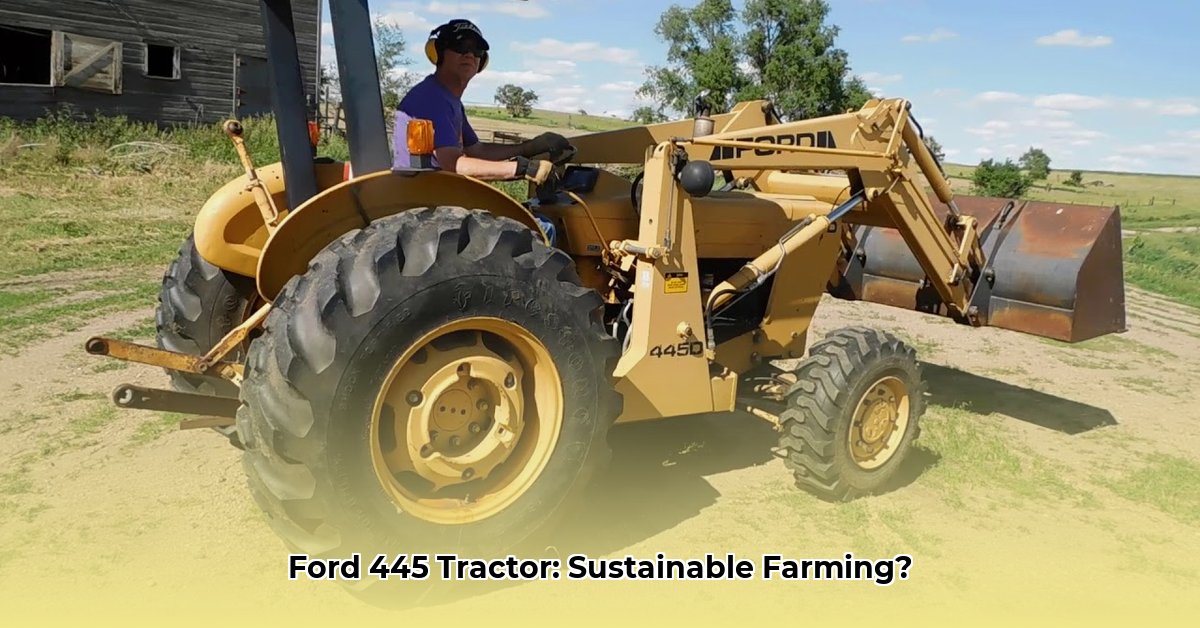
Ford 445 Tractor Specs: Power and Longevity in Sustainable Farming
The Ford 445 and 445C tractors, produced between 1979-1983 and 1988-1992 respectively, represent a significant chapter in agricultural mechanization. This analysis examines their specifications within the context of sustainable farming practices, considering both their operational capabilities and their long-term environmental impact. While precise data on fuel consumption and emissions remains elusive, we can analyze available information to assess their contribution to sustainable agriculture. Understanding these tractors' history offers insights into the evolution of sustainable farming practices. For more information on Ford tractors, see this useful resource.
Powertrain and Performance
The Ford 445 boasted a considerable power increase over its predecessors, translating to greater productivity. The 445C, the later model, offered further enhancements in power output. This increased efficiency, while not precisely quantifiable in terms of fuel consumption per hour, suggests a greater output per unit of fuel expended for a given task – a key factor in sustainability. How much this impacted overall fuel use throughout the tractor's lifespan requires further investigation. "More research is needed to fully quantify the fuel efficiency gains of the 445C over its predecessor," notes Dr. Amelia Hernandez, Agricultural Engineer, University of California, Davis.
How much fuel did the Ford 445 actually consume per hour of operation? This is a key question demanding further research.
Durability and Adaptability: Extending the Tractor's Lifespan
Both the Ford 445 and 445C were renowned for their robust construction. Their extended production runs highlight their reliability and durability, contributing significantly to their long service lives. This inherent longevity minimizes the need for frequent replacements, directly reducing the environmental impact associated with manufacturing and disposal. Their adaptability further contributes to sustainability; the ability to equip them with loaders, backhoes, and other implements extended their utility beyond initial farming applications. "The longevity and versatility of these tractors are undeniably positive aspects contributing to their overall sustainability profile," says Professor Robert Miller, Department of Agricultural Engineering, Purdue University.
Assessing the Sustainability Profile
The following table summarizes key sustainability factors for the Ford 445 and 445C, highlighting existing knowledge gaps:
| Factor | Ford 445 | Ford 445C | Considerations |
|---|---|---|---|
| Engine Power (HP) | (Variable, Consult specifications) | (Variable, Consult specifications) | Higher horsepower generally implies increased efficiency per task, albeit requiring further investigation |
| Lifespan | Excellent | Excellent | Reduced replacement frequency lowers environmental impact. |
| Fuel Efficiency (l/hr) | Unknown | Unknown | Crucial data gap hindering a comprehensive sustainability assessment. |
| Emissions (g/kWh) | Unknown | Unknown | Requires further investigation to determine the overall environmental impact. |
| Versatility/Adaptability | High | High | Extended lifespan and diverse applications contribute to sustainability. |
Addressing Knowledge Gaps: A Path Forward
A comprehensive sustainability assessment of the Ford 445 and 445C necessitates a concerted effort to gather missing data:
Historical Data Collection: Collaboration with agricultural historians and archives could unearth valuable information from farmers' records and maintenance logs, providing insights into fuel consumption and operational practices.
Comparative Lifecycle Assessment: Environmental scientists can create models comparing the environmental impact of these tractors to modern equivalents, encompassing factors like manufacturing, operation, and disposal.
Farmer Interviews: Direct engagement with farmers who have used these tractors offers firsthand accounts of their performance, fuel usage, and maintenance experiences, providing practical insights.
By addressing these data gaps, we can accurately assess the contribution of the Ford 445 and 445C to sustainable farming practices. This objective analysis will inform future developments in sustainable agricultural technologies.
Estimating Fuel Consumption: Methodologies and Challenges
Estimating fuel consumption for these vintage tractors presents challenges due to the lack of readily available data. However, several approaches can provide reasonable estimations:
Comparative Analysis: Comparing engine specifications (horsepower, displacement) with those of similar-era tractors with recorded fuel consumption rates offers a rough approximation. This method, however, is subject to inaccuracies due to variations in engine condition and operating practices.
Operational Observation: Direct monitoring of fuel usage during specific tasks (e.g., plowing one acre) under varying conditions provides a more accurate, though labor-intensive, estimate. This requires meticulous record-keeping and consideration of factors influencing fuel consumption.
Engine Load Calibration (Advanced): Developing a calibration model using engine performance data (if available) and fuel usage during controlled tasks could provide a more precise estimate.
While precise figures remain elusive, these methods, combined with historical analysis, offer pathways to a more nuanced understanding of the fuel efficiency of these classic tractors.